#Beef And Vegetable Kebab
Explore tagged Tumblr posts
Text
In the 1960s, I happily ate some cream soup, oxtail soup, red cabbage soup, chicken soup, kidney soup, onion soup, safflower chicken soup, dumpling soup, red fish soup, cabbage puree soup, barley rice soup, assorted soup, chicken and abalone soup, chicken soup, Italian noodle soup, asparagus soup, and roast beef. Steak, fried beef, curry beef, beef terrine, sour beef, mutton kebabs, roasted leg of lamb, roasted horse, braised lamb, pan-fried lamb chops, pan-fried lamb liver, steak, fried beef, curry beef, beef terrine, sour beef, mutton skewers, roasted leg of lamb, grilled horse, braised lamb, pan-fried lamb chops, pan-fried Lamb liver, steak, fried beef, curry beef, vodka beef, sour beef, steamed fish pudding, grilled mandarin fish, pan-fried (fried) mandarin fish, soft fried mandarin fish, grilled fish greens, grilled Moscow red fish, grilled fish with custard, grilled fish with green vegetables, boiled fish with spinach, grilled prawns, grilled shrimps, shrimp noodle box, fried prawn noodles Shrimp, curry prawns, canned braised prawns, soft-fried prawns, lettuce prawns, butter chicken rolls (chicken steaks), soft-fried chicken patties, chicken patties, chicken yuan, king chicken patties, shredded chicken, canned braised chicken, red braised chicken, braised chicken with onions, braised chicken with vegetables, paper-wrapped chicken, chicken nuggets, coconut chicken, butter chicken
97 notes
·
View notes
Text
discussing all things arab in jwct s2e05!
first off, that is shish tawook (chicken kebab), not beef. but overall a pretty good representation of fast food in the arab world. white rice is an extremely common side dish with kebabs (alongside grilled vegetables like tomatoes, onions, peppers) and that little container is garlic which is common to put on meats. particularly pita bread wraps/sandwiches.
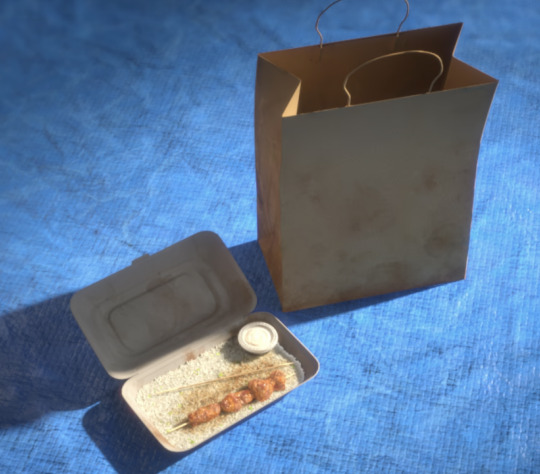
and she really didn't need to say "beef" kebab. only chicken kebab really gets singled out. really outting yourself as a foreigner there, brook. broadly, the default for all meat-based dishes will either be lamb or beef. and no menus will not clarify which it is 90% of the time. they force you into russian roulette.

moving on to the few lines of arabic they speak, this is probably the MOST fascinating part. arabic is not like english. there is universal language which is derived from the qur'an and regional cultural language. modern standard arabic is basically "formal" arabic that is used in international business, government documents, the news, etc. this is the kind of arabic you'd learn in the united states from a textbook. however, native speakers have regional dialects. regional dialects are SO expansive that it's argued that many of them might actually be qualified as separate languages. even the same country might not be able to understand each other because of things like rural vs urban language developments.
why does this matter? soyona speaks egyptian arabic. this is the dialect you'd use to communicate in places like cairo. egyptian is ALSO the "film" language. egyptians completely dominated the arabic speaking film industry meaning it's widely understandable to arabs who grew up in the age of television. but it's also famous for having a thousand unique words that make you go "what the fuck does that mean".
as someone who lives in dubai, soyona should actually be speaking gulf arabic on a daily basis. gulf arabic is the common dialect of lower saudi, the UAE, most of oman, etc. it's also famously not spoken any where near cairo. it'd be equally understandable if soyona spoke MSA to brooklynn as that's likely what she'd speak with trading partners. i must stress that arabic dialect isnt like americans talking to british people. it's closer to spaniards talking to french people. you kind of get the gist but only kind of.
while meta-wise we know this wasn't something the crew intended, it adds an interesting layer to soyona's canon lore. while egyptian is something somewhat *understood*, it is NOT the common language of where she's doing business OR the common dialect overall. meaning she almost certainly has to have some major base of operations in cairo, too, and it likely happened before moving to the gulf.

brooklynn ALSO speaks dialectal arabic! for her, it makes a lot of sense with the previous mention of egyptian being the "film" language. she could've honestly picked this up by watching a few shows on the way over. and fun fact, it's also dialectally what yaz would say as a lebanese since the same words are used in levantine. however, again, this is definitely NOT msa meaning it's extremely unlikely she picked it up from a textbook or any kind of formal language learning platform.
moving on, we have fashion: brooklynn, dear. you look like such a tourist. no wonder she caught you so easily. the tight, ripped pants and short sleeved, close fitting t-shirt give her away instantly. while yes you'd be allowed to dress like this, everyone knows you're an american vacationer instantly. you might be able to get away with this in the levantine cities, but the GULF? her ass is NOT the delivery woman.

soyona actually hits the nail pretty well for what a local would dress like. she's got a bit of a "western" influence to her, but honestly that's how a lot of the upper business class dresses in the modern era. her sleeves are long and to the wrist, her pants are long, and she's got a loose overcoat. she looks very much like she shops designer which is exactly how a local would display wealth. the only thing she's missing is gold jewelry honestly.

lastly, there's the elephant in the room... the gulf. we call people from this place khaleejis. everyone outside the gulf hates khaleejis. even non-khaleejis in the gulf hate khaleejis. the kind of rich opulence you see in this apartment is exactly what you'd expect from a khaleeji.
one of the worst places of the animal wildlife trade is in the gulf. while certain regulations have since been put in place, being at the center between africa and asia with some of the wealthiest people in either region makes it prone for animal trafficking. big cats are seen as one of the ultimate status symbols for the ultra wealthy. dinosaur trafficking moving to dubai is about as realistic as it gets.

the only unrealistic part is the lack of visible indentured servants. to put it frankly, the cultural norm is to have a pseudo-slave (90% of dubai is made up of a non-khaleeji slave class. i'm serious. and westerners like soyona make up a significant portion of the slave-owning class. the building brooklynn was staying in was 100% actively being built by slaves) who lives in one of your guest bedrooms. it's actually weirder and more sus if she doesn't have one. pair that with soyona wanting to sell militarized dinosaurs which will be used exclusively on the areas exploited by the dubai elite and umm... well, lets close that can of worms before this gets really awkward
70 notes
·
View notes
Text
Nublar 6 cooking/food headcanons because I find it fun.
Sammy -
LOVES cooking and baking and is probably the best cook out of the group.
Her favorite meat alternatives are usually mushroom-based or chickpea-based. She keeps frozen chickpea patties in her freezer as a quick meatless protein option, and especially living with Yaz, she eats something with chickpeas in it several times a week.
Still eats eggs and dairy products, but she can be very strict about where she gets them. She doesn't even care if it's more expensive or not, she wants to be 100% sure the dairy farms she buys from are ethical and treat their cattle as nicely as possible. The eggs are from her own chickens. (She does still have the two cows, Bessie and her calf, but she's not interested in any breeding beyond Bessie's one calf so they're not really a source of milk)
Has a big sweet-tooth, but prefers baked goods over candy.
Always experimenting with new recipes and new vegetarian alternatives to things.
Grills like nobody's business and hosts summer barbecues for her friends.
Yaz -
Eats a lot of Lebanese food because her mom would cook it a lot when she was growing up.
Her favorite food of all time is her mom's kafta (kebabs) since she isn't so fond of pizza anymore after all the soggy, frozen-and-melted pizza on Nublar. She doesn't often make it herself since there's rarely meat in her and Sammy's house and the vegetarian alternative just doesn't hit the same for her, but every so often she craves it and tells Sammy they're having separate dinners tonight.
On that note, definitely not vegetarian, but eats meatless meals 90% of the time because she usually prefers for her and Sammy to have the same meals. Usually only eats meat when they're out or if she REALLY wants it.
Prefers salty over sweet, and prefers chocolate over anything else when she does eat sweets.
Certified peanut butter lover.
Fairly skilled cook, but Sammy is probably better.
Kenji -
Throws random shit in a rice cooker and lives with the result.
Big fan of rice cooker meals due to the lack of space in his kitchen, and usually just eats out of the rice cooker so he doesn't have to wash dishes.
Has a "signature" chili recipe where he cooks ground beef and throws it in a Doritos bag with beans and cheese, which he calls "Chili Kon Carne".
Could not cook for SHIT until he moved in with the Bowmans. Now, he has a perfectly decent cooking ability but chooses chaos.
Prefers savory dishes. Doesn't eat a lot of sweets unless Sammy sends them in her care packages.
Only enjoys cooking when he has someone to cook with, hence a lot of his meals being quick and thrown together. He would order delivery a lot if he didn’t live in a trailer in the mountains. But when he visits Mrs. Bowman for holidays he loves to help her make dinner.
Ben -
Average college dorm shit.
Doesn't like the dining hall at his school so his diet primarily consists of instant ramen, cheap frozen meals, whatever free food he can scrounge up at campus events, and microwaved experiments (cough cough gluten free mug pasta).
Lives for Sammy's care packages because "holy shit I get to eat cake?????"
Doesn't have a huge sweet-tooth but goddamn if he doesn't love care package cake.
Always been a big vegetable enjoyer and tries to squeeze them in however he can.
Brings back several containers of food whenever he visits his mom.
Darius -
Absolutely can cook because his mother raised him right, but rarely does.
Girl dinner SUPREME. Spray-cheese on crackers makes frequent appearances at dinnertime. Other favorites include pickles, tuna straight out of the can, and a banana wrapped in a tortilla with peanut butter (add whipped cream to make it dessert).
Doesn't really have a lot of flavor preferences, he's always been a good eater, but he can't STAND olives. Just olives. He'll eat just about anything else.
Also refuses to eat a good chunk of the things Kenji makes. He doesn't like to have a bunch of random things that don't complement each other mixed and cooked together when he could just eat the ingredients separately.
Like Kenji, enjoys cooking as a social activity more than anything else, and far more willing to cook for other people as opposed to just himself. If he has anyone visiting, he'll make them a real dinner no questions asked.
Makes REALLY good pancakes which he thinks are totally average, but when Brooklynn stayed at his cabin and he made them for her, she would not shut up about how good they were.
Brooklynn -
Never really learned how to cook as a kid. She can make sushi rolls because she was doing a video on it, but otherwise she can really only make a sandwich or boil pasta because she spent most of her childhood eating what her dads made or traveling and living on restaurant/convenience store food.
Mooches off other people for food. If she's with her dads, she eats what they make. If she's visiting Ben, she sneaks into the dining hall. If she's visiting Yaz and Sammy, she gets treated to an absolute feast of Sammy's food. If she's visiting Darius, he'll make pretty much whatever she wants. If she's visiting Kenji, she will happily eat out of the rice cooker with him.
100% that one friend who will sit there hungry for four hours until someone decides to make food so she can ask if she can have some.
The least picky person in the group, will eat ANYTHING that's reasonably edible.
Is open to learning to cook and will help with meal preparation if asked. Eventually picks up some skills from watching her friends and starts hitting them up for recipes.
When in doubt, she tends to order delivery.
#jurassic world chaos theory#jwct#sammy gutierrez#yasmina fadoula#darius bowman#ben pincus#kenji kon#brooklynn jwct#yasammy#crumbs but there#headcanons
32 notes
·
View notes
Text
Die's Food Diary in Europe (March 2024 tour)

For the magazine Weekly Shinchou April 25th 2024 issue, Die wrote a blog of what he ate on Dir en grey's trip to Europe. Their flight lasted 14 hours.
March 18th – After landing in Warsaw, he went to a seafood restaurant but seeing as he doesn't like seafood or raw food, he ordered a beef steak, which he was satisfied with.
March 19th – Die ate breakfast at the hotel. The buffet typically contains ham, scrambled eggs, salad, bread and coffee. There were sausages and bacon, but they seemed oily/greasy and he was concerned about how much fat they contained. By the third day there though, he started getting bored with that menu.
The lunch is catered by the venue for the concert. It had ham, cheese, bread and minestrone. Because it was the first day and that preparations were hectic, he actually went on stage for that first show without eating dinner. After the show ended, he enjoyed a traditional Italian risotto with mushrooms.
March 20th – Before the second show, he ate pierogi for dinner. He commented that it looks like gyoza but that the taste is "modest"? He also highlighted how it was difficult to get used to the time of day because of how late the shows start in Europe.
March 21st – The band and the staff left on a double-decker bus toward Paris. Die bumped his head on the ceiling of the second floor because it's really low. The bunk beds are narrow for his height but they're decent once he got used to them. They all ate from a service area/stop along the way but Die, not wanting to succumb to the temptation of eating fast food, ate leftovers of a burrito prepared the previous night... which he then realizes can count as fast food too hah.
March 22nd – He ate from traditional French home-style meals that appeared to have been cooked in-house at the venue. Die was excited to try the food out but all the names were in French... The only meal that he could recognize visually was a quiche. I think he ended up trying a few regardless of not knowing what he was eating and he was satisfied.
Die was a bit nervous before going on stage because of the Bataclan's tragic event in 2015 (terrorist shooting). After the show, he had take-out bolognese pasta with thick noodles.
March 23rd – Apparently a fan from Japan gave them takoyaki, which was however heavier than pure takoyaki. He found the taste powdery. All the band members stuffed their faces with takoyaki. The band always receives a bunch of instant food from Japanese fans when they tour overseas, it seems. If someone on the bus starts eating something like ramen, the others are lured in by the smell and they will likely indulge as well. He doesn't usually take (instant?) ramen in Japan, but he finds it tasty on tour overseas.
For dinner, he had kebabs before the show, and pizza afterward. In the end, he did succumb to junk food.
March 24th – Breakfast was served on the ferry boat's restaurant. He took fried eggs, mushrooms, tomatoes and bread while looking out at the sea. At night, he went to a local yakiniku-style restaurant with his American friends. While the atmosphere was similar to a Japanese yakiniku, he felt sorry for his friends about the taste of the food.
......... A menu critic highlighted at the end of the diary that Die had not eaten any fruit or vegetables hahah.
160 notes
·
View notes
Text
Recipes for Sun God Nika/Monkey D. Luffy
Vegetarian:
Vegetable Fried Eice
Fried Bell Peppers
Garlic Sesame Soba
Brown Rice Sushi
One-Pot Pasta
Seafood:
Seafood Kimchi Fried Rice
Creamy Seafood Risotto
Seafood Laksa
Seafood Rice
Spicy Seafood Creole
Seafood Pasta
Crab Rangoons
Salmon Cucumber Sushi
Chicken Teriyaki Sushi
Grilled Kebabs and Pasta
Beef/Pork/Chicken:
Swedish Meatballs
Stuffed Bell Peppers
Homemade Oden
Beef and Green Bean Soba
Beef and Vegetable Stew
Beef Stir Fry
Mongolian Beef
Beef Stroganoff
Spinach Beef Pasta
Creamy Beef Pasta
Ground Beef Mongolian Noodles
Indian Chicken Curry
Chicken and Dumplings
Chicken Veggie Ramen
Chicken Alfredo Pasta
Pan Seared Steak
Braised Pork
Pork Stroganoff
Miscellaneous
Chick-fil-A sandwich/meat
#og.txt#popculture magic#paganism#pop culture paganism#one piece paganism#pcp one piece#one piece pcp#one piece luffy#one piece#sun god luffy#sun god nika#recipes
12 notes
·
View notes
Text
Authentic Turkish Döner Kebab
Döner kebab, or 'the Döner sandwich', is a dish that originated in Turkey. The meat is strung on a spit that cooks vertically. Originally, seasoned lamb is used for this. Nowadays, you often buy the variant with beef or chicken. After roasting, the meat is cut into thin strips from the spit with a long knife. The Döner is put in a Pide, Pita, Lavash bread or Dürüm (a kind of Mexican Tortilla made from Dürüm wheat) together with vegetables and sauce.
Spiced Döner Kebab is usually served with bread or Dürüm with sliced tomatoes and onions, but let me make a recommendation: in Istanbul, I had these Döner Kebab with warm fries, Onion Sumac Salad, sliced pickles, and tomatoes. It was outstanding!
To make this dish at home, you need a spit - or at least, you would think so. You can't believe how easy it is to make a Takeaway Shop Döner Kebab at home, this easy recipe is perfect for a Takeaway made at home at a fraction of the cost. This recipe including the Onion Sumac Salad, authentic Takeaway Garlic Sauce, authentic Takeaway Chili Sauce and of course the Döner Kebab bread.
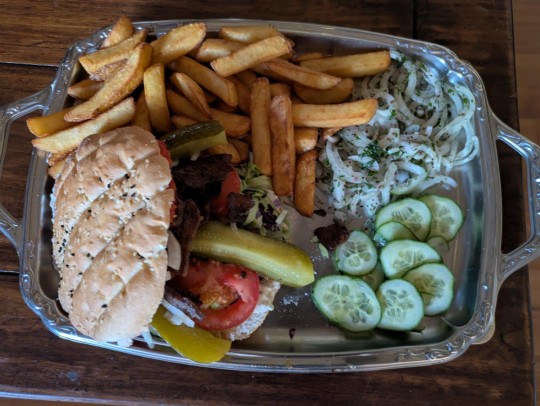
Ingredients:
500 grams mince meat
1 teaspoon of Salt
1/3 teaspoon of Black Pepper
2 teaspoons of Paprika Powder
2 teaspoons of Cumin Powder
2 teaspoons of Onion Powder
2 teaspoons of Garlic Powder
1 Onion
2-3 cloves minced Garlic
1 heaped teaspoon of Tomato puree
50 grams Greek Yoghurt
2 tablespoons of neutral oil
Preparation:
Step 1:
Peel the onion and place it in a food processor, grind it very finely. Place it in a fine sieve and press the water out over the mince meat with a spoon.
Step 2:
Mix the Salt, Black Pepper, Paprika Powder, Cumin Powder, Garlic Powder, Garlic cloves, tomato puree, yoghurt and oil through the minced meat.
Step 3:
Roll the minced meat mixture into a thick, long sausage and wrap it in cling film. Place it in the refrigerator for a maximum of 1 day so that all the flavors have been properly absorbed into the meat. Then put it in the freezer for 3 hours.
Step 4:
Then cut the Döner Kebab into very thin slices with a sharp knife and fry them in a little oil.
NOTE:
If you can’t not find Greek Yoghurt, you can add a bit of Labnen or Kefir.
Authentic recipe for Takeaway Kebab Shop Chilli Sauce
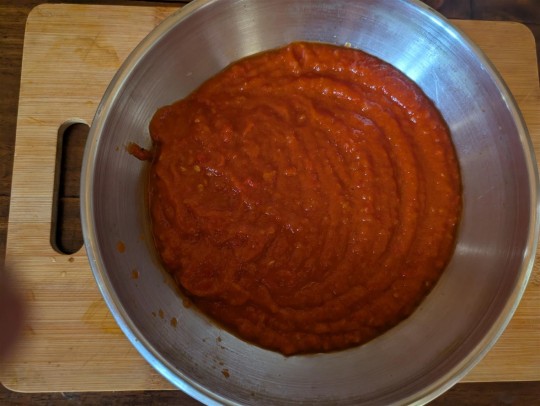
Ingredients:
1 medium Onion
2 tablespoons of Olive oil
2 cloves Garlic
1 heaped tablespoon of Tomato puree
3/4 teaspoon of Salt
1/2 teaspoon of Sugar
2 teaspoons White Vinegar or Lemon Juice
1 standard sized tin of chopped Tomatoes
3 Red Chilies
Preparation:
Step 1:
Finely chop the onion. Chop the garlic. Cut the chilies into rings.
Step 2:
Add two tablespoons of Olive oil to a pan over medium heat and fry the Onion for a few minutes. Add the Garlic and fry for a few minutes. Add the Tomato puree, Salt, Sugar, Vinegar and the Chilies and stir well for a few minutes. Add the chopped Tomatoes and turn off the heat while stirring everything together.
Step 3:
Place everything in a food processor and blend until smooth.
Authentic recipe for Takeaway Kebab Shop Garlic Sauce
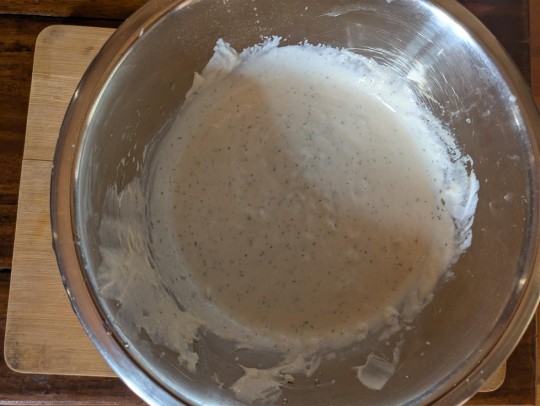
Ingredients:
150 grams Mayonnaise
150 grams Greek Yoghurt
Half a teaspoon of Salt
Pinch freshly ground Black Pepper
2-3 cloves of fresh minced Garlic
1 tablespoon of Lemon Juice
1 teaspoon of Garlic Powder
1 teaspoon of Dried Mint
A little water if needed
Preparation:
Step 1:
Chop the garlic cloves very finely.
Step 2:
Place the Mayonnaise, Yoghurt, Salt, Black Pepper, Lemon Juice, minced Garlic and Garlic Powder in a bowl and mix well.
Step 3:
Add about two tablespoons of water and stir it in. Add the Mint and stir it in.
Authentic recipe for Takeaway Onion Sumac Salade
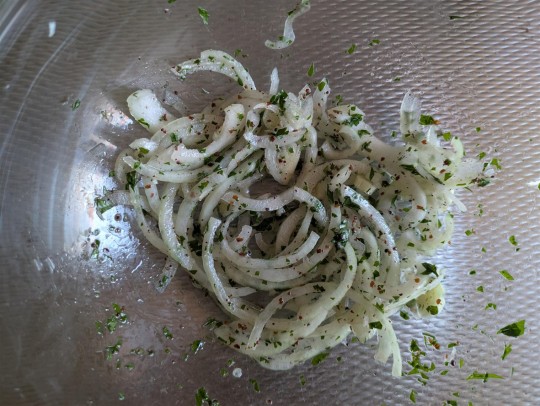
Ingredients:
1 Onion
8 sprigs of Parsley
1 teaspoon ground Sumac
2 tablespoons Olive oil
Preparation:
Step 1:
Thinly sliced the onion into semicircles. Chop the Parsley.
Step 2:
Put everything in a bowl and mix well.
Turkish Döner Kebab bread:
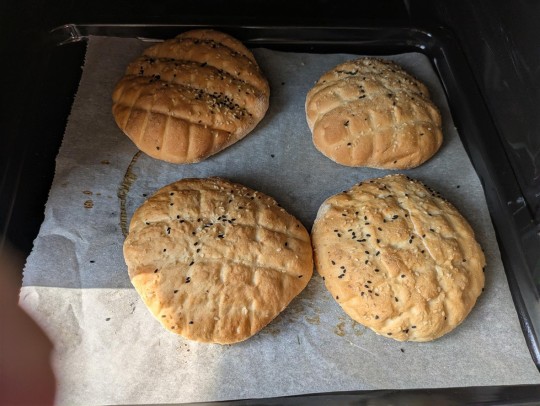
Ingredients:
500 grams Pizza Flour
1.5 teaspoon Salt
1 teaspoon Sugar
1 sachet of Dried Instant Yeast (7 grams)
150 ml lukewarm Water
150 ml lukewarm Milk (If using normal Bread Flour or all purpose Plain Flour drop the Water and Milk to 125 ml)
50 grams or 5 tablespoons neutral liquid oil
50 grams Yoghurt
Beaten Egg and a splash of Milk
Sesame seeds and Nigella seeds
Preparation:
Step 1:
Mix everything together into a smooth bread batter. Cover the bowl with cling film and let it irest n a warm place for 1 hour until it is doubled in size.
Step 2:
Cutting the dough into eight pieces and roll them into smooth balls. Let them rest for about 10 minutes under cling film.
Step 3:
Roll the balls with a rolling pin hand-sized. Place them on a baking tray and let them rest again under cling film for about 30 to 40 minutes.
Step 4:
Brush the top of the bread with the Egg mixture and sprinkle some Sesame seeds and Nigella seeds over it. Bake in a well preheated oven at 230 degrees Celcius (fan setting, that's around 450 Fahrenheit) for 10-12 minutes.
For the topping of the Döner Kebab bread:
Ingredients:
1 Onion
1 Tomato
White Cabbage
Red Cabbage
Iceberg Lettuce
Sliced Pickles
Preparation:
Step 1:
Cut the Onion into thin half rings. Cut the Tomato into thin slices. Chop the Red Cabbage, White Cabbage and Iceberg Lettuce finely.
Step 2:
Sprinkle some Salt and Vinegar over the Red Cabbage and gently squeeze it together. Set aside.
#turkish#turkey#recipes#kitchen#delicious#cooking#dinner#take away#doner kebab#meat#bread#vegetables#garlic sauce#Chili Sauce#authentic#classic#real#homemade#instanbul#lettuce#cabbage#pickles#tomatoes#onion
2 notes
·
View notes
Note
(This is kinda a basic question) but what are the weavers and Sam’s favorite foods/drinks?
The weavers + Sam’s Favourite foods
———
Benny’s favourite/s: Christmas fruit cake, civil war cake, chocolate potato cake, roast beef, chicken pudding and clam chowder.
Tim’s favourite/s: ambrosia, apple sauce cake, scalloped potatoes, peanut butter and jelly sandwiches and certain stews.
Tom’s favourite/s: similar to Tim, but his is apple pie, baked lamb, mashed potatoes and vegetable soup.
Caleb: baked lamb, certain soups, ambrosia, chicken pudding cheese sandwich and pound cake
Lilian’s favourite/s: apple sauce cake, ambrosia, mashed potatoes, peanut butter and jelly sandwiches, roast beef.
(Most of their foods is… interesting and normal to say the least. But with the twins it’s a rarity to get any of these unless they make it themselves)
Travis’ favourite/s: croissants (thanks to Duncan), classic pepperoni and cheese, ramen, sushi, bento and Pho soup either with beef or chicken (only thing close to his heritage), burgers and fries
Duncan’s favourite/s: plain cheese pizza, bouillabaisse, clafoutis (the ‘s’ is silent), crêpes, ratatouille, Soupe a l'ognion, chicken curry, kebab wraps
Sam’s favourite/s: tamales, arepa con queso, buñuelos, asopao de pollo (from a friend), Postre de natas, ham and pepperoni pizza and strawberry cake.
———
I have been waiting for this question for a long time. Thank you so much for asking!
And it’s not basic at all, since the weavers are from the 1920’s and favourites are very difficult, I kinda try to keeps these short but readable so the favourite drinks are gonna have to be in a different post... sorry.
#wick hellbent games#wick 2015#wick horror game#wick#wick au#wick sam#wick tom#wick tim#wick Lilian#wick caleb#wick benny#asks#asks and replies#wick travis#wick duncan#I don’t know why people like to think asking about favourite foods is basic#… it’s not#it’s actually pretty complex because of all these different foods
11 notes
·
View notes
Note
What would be the gang member's reaction to pizza for the first time (+what would be their favorite toppings?)
Honestly, I don't think their reaction would be too big, but that also depends on the pizza you decide to show them. If it's one of the classics like pepperoni, just cheese, ham, mushroom etc. then I believe most of them would just go "cool okay".
But if it's something "out of the ordinary" like that one Swedish pizza with banana, curry and ham then weeeellll. They might be a bit hesitant (I know I was when I first had that one), but camping out in the wild and food being something to pretty much always worry about, I think that would be alright too.
I'll just list the members of the VDL gang under the cut <3
Arthur - classic pepperoni
John - pineapple
Sadie - kebab pizza, even better when there are fries on top too
Abigail - mushrooms
Hosea - there's one from my hometown where they throw on different kinds of salami and pepperoni and some fried eggs
Jack - the one that has four kinds of cheese
Reverend - the banana pizza I mentioned earlier
Dutch - a classic calzone
Mary-Beth - olives, cherry tomatoes
Pearson - salmon and spinach
Sean - BBQ chicken
Javier - seafood like shrimps and oysters
Tilly - fresh basil, mozzarella and maybe some ham too
Charles - fried vegetables, ham and olives
Micah - same as Hosea, but minus the egg. If any basil or olives make their way onto his pizza, he will get rid of it immediately
Bill - also four cheese and occasionally with meat on top
Uncle - tuna and red onions
Karen - minced meat
Molly - just sauce and cheese
Susan - rucola and some hard cheese sprinkled on top
Kieran - beef
Lenny - kebab, but without fries
4 notes
·
View notes
Text

Some meals I had in Toronto during the election and immediate aftermath.
M had a show up in Toronto that had him leave on Election Day, and I went with him because I knew no matter what, I didn’t want to be alone for several days following it. I also had never been to Toronto, so this felt as good an opportunity as any.



We spent election night and a few days afterward by the Toronto Airport as that’s where the show was located. I found this local chain called The Keg Steakhouse and Bar, and they had a pretty awesome happy hour where you could get prime rib sliders and tuna tartare for a good price. I also went with the lobster bisque because I wasn’t feeling that hungry, but it hit the spot for something warm and comforting.


The next day, I barely ate as I had zero appetite, but we walked to the Lone Star Texas Grill--another Canadian chain--where they had $4 tequila shots and a really nice chicken adobo quesadilla that hit the spot after I forced myself to do some swimming in the hotel pool in the afternoon.




Thursday I was determined to actually do something, so I got a swim in and then took the UP Express into downtown Toronto. I had a whole list of places that I wanted to go to, but this was more of a reconnaissance trip to get familiar with the layout of downtown before M and I would arrive the next day for 36 hours in the city. I took a walk to Sud Forno, a fun multi-story Italian cafe and restaurant, and treated myself to a lovely portion of cacio e pepe. I had dinner at the hotel later and it was fine, but it didn't need to be documented--though I did have a strawberry and greens salad as I realized I needed more vegetables.





Friday afternoon we went into Toronto together, and started at Chefs Hall which was a couple of blocks from our hotel. I had another quesadilla (trust me, my food choices will improve with dinner) and M had shawarma-style chicken kebabs and rice with a variety of sauces. I had a lovely conversation with a bartender about the election, in which he said that living in Canada lately had been like living next to a crackhouse, waiting to see if the crack dealer would be let back in. Given the shit that the stupid president-elect has been saying about making Canada a state, I definitely want to come back here to ask him how he feels now.









The absolute highlight of the trip, to be honest, was dinner at Aloette that evening. M’s Canadian colleagues were impressed that we were able to get a spot at the bar as walk-ins, but we settled in for a magnificent meal of beef tartare, an iceberg wedge salad, hamachi crudo, salmon tartare with shiso and compressed cucumber, and some fried chicken lettuce wraps. If anything, it was the meal that really brought me out of my funk because as delicious as the food was, the care given to us by our server really made the meal special. We told her what we wanted, she spaced it out accordingly, and we enjoyed one hell of a meal during our allotted two-hour dining window.
3 notes
·
View notes
Text
Deutschribing Germany
Cuisine
Meal times
The German proverb Iss dein Frühstück wie ein Kaiser, Mittagessen wie ein König und Abendessen wie ein Bettler (Eat your breakfast like an emperor, lunch like a king, and dine like a pauper) sums up the German outlook toward meals.
A typical day begins with Frühstück (breakfast), when people drink coffee, tea, or hot cocoa and eat muesli with yogurt or milk or bread with butter, jam, honey, chocolate and hazelnut spread, sausage, or cheese. Some people also drink juice and eat a boiled egg. This usually takes place between 6 and 8 a.m. Children usually eat a mid-morning snack at school called Pausenbrot (recess sandwich) that consists of a sandwich, a piece of fruit, or a muesli bar. The adult version is called Zwischenmahlzeit (in-between meal).
Mittagessen (lunch) takes place between 12 and 2 p.m. A typical lunch dish includes potato salad with sausage or meatballs and meat with potatoes or vegetables. It is common for family members and friends to gather between 3 and 5 p.m. for Kaffee und Kuchen (coffee and cake).
Abendessen (dinner) is eaten between 6 and 7 p.m. Sometimes it is a light cold meal with bread and cold cuts, in which case it is called Abendbrot (evening bread). Dinner normally consists of a salad or soup, bread, cheese, meat or sausages, mustard, and pickles.
Dishes
German cuisine varies from region to region, and what is considered typically German is actually typical in the south, mainly Bavaria, where cuisine is similar to that in Austria. There are also international varieties such as doner kebab, pizza, sushi, Chinese food, Greek food, Indian food, and Vietnamese food.
Bread and sausage are staples of the German diet. There are about 600 types of bread and almost 1,500 sausage varieties, including Bratwurst (made of ground pork, beef, or veal and spices) and Weißwurst (white sausage eaten with sweet mustard, a pretzel, and beer).
The national alcoholic drink is beer, of which there are many varieties, including Helles (a pale lager beer produced in southern Germany), Radler (a beer mixed with lemonade), and Weizenbier (a top-fermented beer brewed with a large proportion of wheat relative to the amount of malted barley).
Berliner/Krapfen/Pfannkuchen
These sweet dough dumplings, filled with jam and glazed with powdered sugar, are known as Berliner in northern and western Germany, Pfannkuchen in eastern Germany, and Krapfen in southern Germany.

Birnen, Bohnen und Speck
Birnen, Bohnen und Speck (pears, beans, and bacon) is a dish made with pears, green beans, and bacon, accompanied by potatoes. It is eaten in Bremen and Lower Saxony.

Bratkartoffeln
Bratkartoffeln (fried potatoes) are fried potato slices with diced bacon and/or onions.
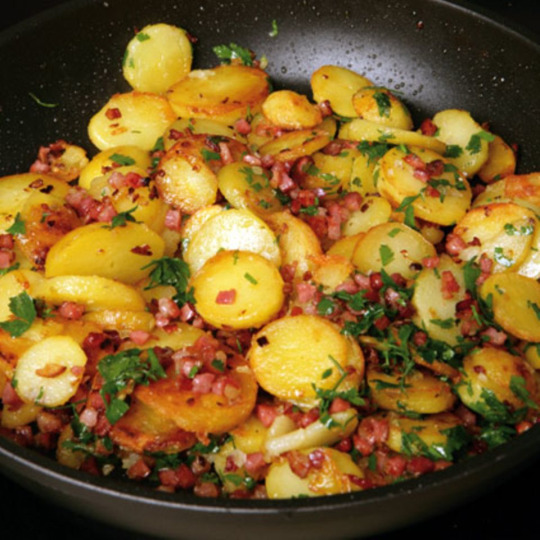
Brezel
Brezeln (pretzels) are baked pastries made from dough and shaped into a symmetrical knot. They are typically seasoned with salt, but can also have toppings such as cheese or seeds.
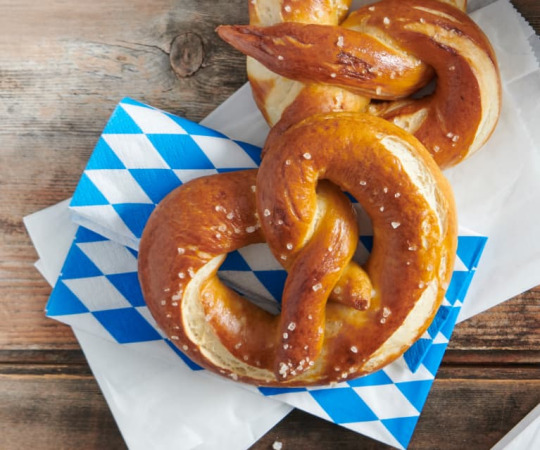
Brot
Brot (bread) comes in many different types, from white wheat bread (Weißbrot) to gray (Graubrot) to black (Schwarzbrot), which is actually dark brown rye bread. Some breads contain both wheat and rye flour and are called Mischbrot. Others have seeds such as linseed and sunflower seeds and are wholegrain (Vollkornbrot). Bread can also be made from spelt (Dinkelbrot), rye (Roggenbrot), or a mix of these with wheat.

Brötchen (bread rolls) are also very common and can be made from the same cereals and seeds as normal bread.
Currywurst
Currywurst is Berlin's most famous dish and consists of a pork sausage with ketchup and curry powder.
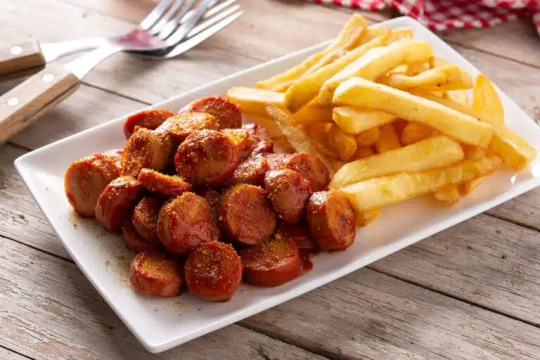
Eierschecke
Eierschecke, whose name is derived from a tripartite piece of clothing, consists of three layers: the bottom one is either a yeast dough or made with baking soda, the middle layer is a cream made of quark, vanilla, butter, egg, sugar, and milk, and the top one is made from eggs, butter, sugar, and vanilla pudding powder. It is a specialty from Saxony and Thuringia.
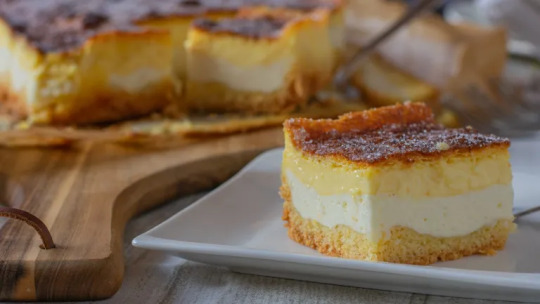
Fischbrötchen
A Fischbrötchen (fish bread roll) is a sandwich made with various fish, either pickled or fried, and onions, common in northern Germany.

Flammkuchen
Flammkuchen means "pie baked in the flames" and originates from Baden in Baden-Württemberg and the Palatinate in Rhineland-Palatinate. It is similar to a pizza with thin crust covered with crème fraîche, onions, and lardons.

Frikadellen
Frikadellen are flat-bottomed, pan-fried meatballs of minced meat. They are commonly eaten with pasta salad or potatoes, or in a bread roll with mustard.

Himmel und Erde
Himmel und Erde (heaven and earth) is a dish with mashed potatoes, stewed apples and fried blood pudding. Potatoes are also called Erdäpfel (ground apples), so it is a meal made with apples that grow above and under the earth. It is popular in the Rhineland in Rhineland-Palatinate and North Rhine-Westphalia, Westphalia in North Rhine-Westphalia, and Lower Saxony.
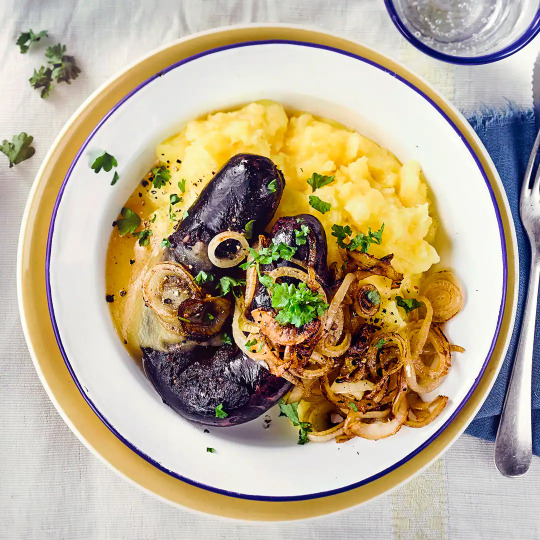
Kirschenmichel
Kirschenmichel is a kind of bread pudding made with cherries and served hot with vanilla sauce. It is typically eaten in Franconia in Bavaria and Thuringia, the Palatinate, Baden-Württemberg, and Hesse.

Klöße/Knödel
These dumplings are known as Klöße in northern, central, and western Germany and Knödel in southern Germany. They are usually made from flour, bread, or potatoes. There are different varieties, including dumplings made of ground liver or breadcrumbs.
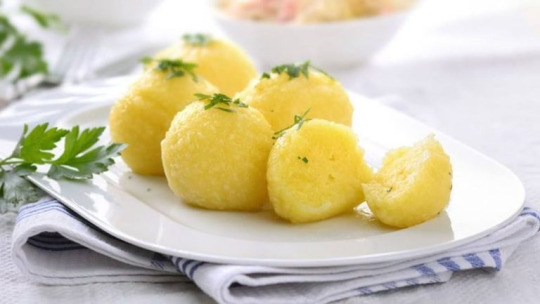
Kohlroulade
A Kohlroulade (cabbage roll) consists of cooked cabbage leaves wrapped around a meat filling seasoned with garlic, onion, and spices. Rinderrouladen are similar but consist of bacon and onions wrapped in beef.

Labskaus
Labskaus is a dish made from corned beef, herring, mashed potatoes, and beetroot, served with a fried egg and a pickled cucumber. It is typically eaten in northern Germany.
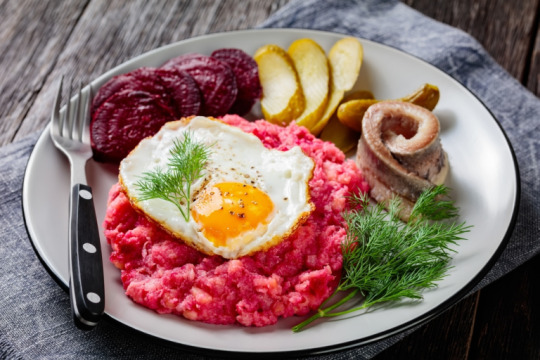
Leberkäse
Leberkäse ("liver-cheese") is eaten in Franconia, Saarland, and Swabia in Bavaria and Baden-Württemberg. It consists of beef, pork, and bacon that are finely ground and then baked as a loaf in a bread pan. It is served with an egg and mashed potatoes.

Leipziger Allerlei
Leipziger Allerlei was invented in Leipzig and consists of a mixture of peas, carrots, green beans, asparagus, morels, and celery. It may also contain broccoli, cauliflower, or corn. It is served with potatoes and a sauce made from crayfish butter, crayfish tails, and semolina dumplings.
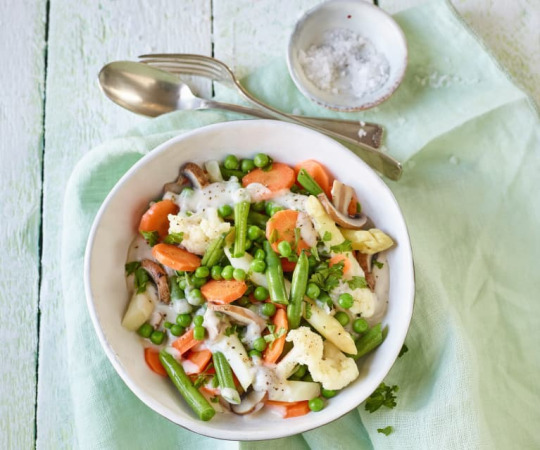
Marmorkuchen
Marmorkuchen (marble cake) has a streaked appearance, achieved by lightly blending light and dark batter. It can be a mixture of vanilla and chocolate.

Maultaschen
Maultaschen ("mouth bags") are large meat-filled dumplings typical of Swabian cuisine. They can also be filled with spinach, onions, and spices and can be either served with broth or cut into slices and fried with eggs.

Pfefferpotthast
Pfefferpotthast (boiled meat pepper pot) is a traditional Westphalian stew made with beef, lard, onions, and spices. It is served with boiled potatoes and salad in the summer and pickled cucumbers and beetroot in the winter.
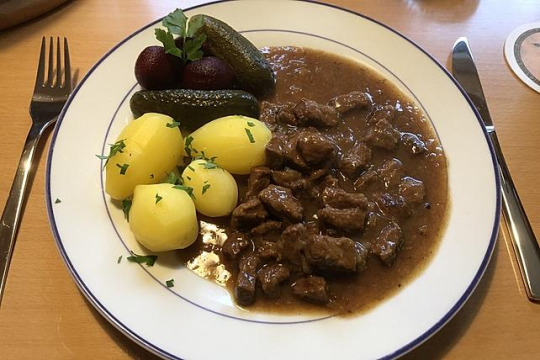
Pinkel mit Grünkohl
It is a dish made from slowly cooked kale served with Pinkel, a salty sausage eaten mainly in Bremen and Lower Saxony.
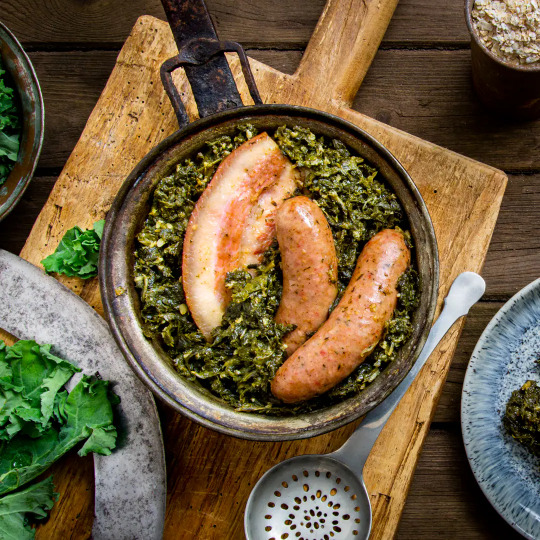
Quarkkäulchen
A Quarkkäulchen ("little quark ball") is a Saxon dish made from quark, mashed boiled potatoes, flour, an egg, and lemon peel. The dough is then baked in the form of a pancake and eaten hot with sugar and cinnamon or with fruit, whipped cream, and vanilla ice cream.

Reibekuchen
These potato pancakes are served with black bread, sugar beet syrup, or stewed apples. They are common in many areas of the country, but the name is characteristic to the Rhineland.

Rollmops
Rollmops ("rolled pug/fat young boy") are pickled herring fillets, rolled around a savory filling, usually consisting of onion and a pickle. It is a specialty from Berlin.

Sauerbraten
Sauerbraten is regarded as the national dish of Germany. It originally comes from the Rhineland and consists of large pieces of beef or horse meat, marinated in a spicy water-vinegar mixture before baking and served with Klöße.
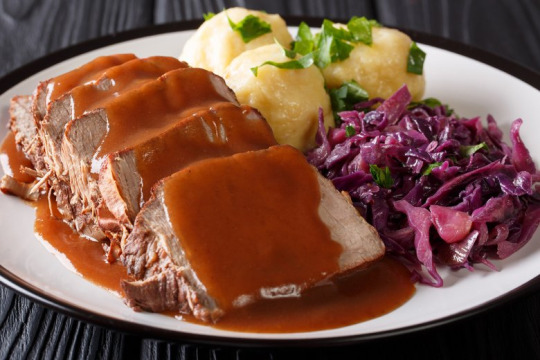
Sauerkraut
Sauerkraut is finely cut raw cabbage fermented by lactic acid bacteria.

Saumagen
Saumagen ("sow's stomach") is popular in the Palatinate and consists of a pork's stomach filled with pork, sausage meat, and potatoes. It is usually served with mashed potatoes or Bratkartoffeln and Sauerkraut.
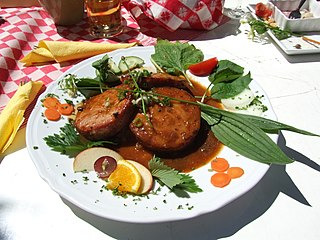
Schnitzel
A Schnitzel is a fried, breaded thin piece of meat, typically pork or beef. Although the most famous one is Wiener Schnitzel (Viennese style), there are other kinds, including Jägerschnitzel, with mushroom sauce; Rahmschnitzel, with cream sauce, and Zigeunerschnitzel, with a sauce made with tomato, bell peppers, and onion.

Schupfnudel
Schupfnudel are thick noodles typical of southern Germany. They are usually made from flour or potatoes and eggs and served with Sauerkraut.
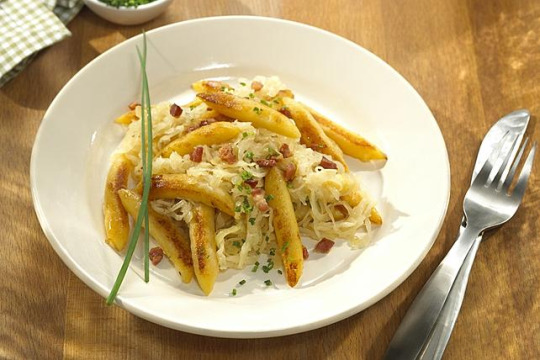
Schwarzsauer
Schwarzsauer ("black sour") is a North German blood soup with spices cooked in vinegar.

Schwarzwälder Kirschtorte
Black forest cake is a chocolate and whipped cream cake with a cherry filling and cherries on top.
Schweinshaxe
Schweinshaxe is a typical Bavarian dish of roasted ham hock served with Sauerkraut. A variation of this dish is known elsewhere as Eisbein ("ice leg"), in which the ham hock is pickled and slightly boiled.
Schwenkbraten
Schwenkbraten is a pork neck steak marinated in spices and onions. It is originally from the Saarland and grilled on a Schwenker, a grill that hangs on a chain over a wood fire.
Spaghettieis
Spaghettieis (spaghetti ice cream) is an ice cream dish made to resemble spaghetti. Vanilla ice cream is extruded through a modified Spätzle press to give it the appearance of spaghetti. It is placed over whipped cream and topped with strawberry sauce to simulate tomato sauce and either coconut flakes, grated almonds, or white chocolate shavings to represent Parmesan cheese.
Spätzle
Spätzle (little sparrow) are hand-made egg noodles, originally from Swabia. They are the main ingredient of several dishes, such as Käsespätzle (Spätzle with cheese) and Linsen mit Spätzle (lentils with Spätzle).
Streuselkuchen
Streuselkuchen ("crumb cake") is made of yeast dough covered with a sweet crumb topping (Streusel). The recipe originated in German Silesia.
45 notes
·
View notes
Text
The Blue Moon Ball: Feast
Oh food glorious food, how I've missed you so. My mind tells me to try and maintain my composure, but my body has already taken off to the nearest spread. It looks like cheese, grapes, crackers, veggies, pinwheels, dip, all the typical light snacks one would find at a party. I begin to realize the severity of my starvation when I completely disregard the silverware, electing to take matters into my own hands by skewering the snacks with magically made icicles. Absolutely barbaric, I know. I end up crafting a chilled charcuterie kebab and scarfing it down. Did I look refined? Probably not, but at this point I'm too hungry to care much for manners. Ivory must also be starving because he detaches from my staff and starts picking at the vibrant berries. Where we live, our diets typically consist seafood, root vegetables, grains, and magical flora adapted to the climate of a frozen coast, so this dinner will be a welcome change of pace. After satiating ours stomachs on a base level, I can begin to truly appreciate the spread. The variety is astounding! I start to search for a real meal. I look at the dining table and see it stretched the length of the hall to an almost imperceptible length. At glance, it looks to be an enchantment that causes the room to loop on itself to accommodate every guest. How clever! I walk past the chairs and benches until I can find a spot that is open and somewhat close to Lurien. I let him get away once, not again. After walking for a bit, I finally spot him. He is surrounded by friends, all laughing while eating away merrily. It doesn't seem a seat is open in that particular circle, but one is available close enough to get in his sight. Moving quickly, I slide onto the bench next to a stranger.
My my mouth waters as I take in the options: chicken, pork, beef, lamb, fish, vegetables of all kinds, exotic fruit slices that look perfectly ripe, bread rolls of every variety and, oh be still my heart, CALAMARI! Ivory and I notice at the same time and immediately snatch the plate. Such golden crispy chewy goodness paired with thick zesty sauces. As we bite down, that oh so satisfying first crunch is enough to make the whole night worth it. Forget the waltz music, this is the real symphony we needed. The squid's flesh gives way to our teeth and we munch away blissfully. Calamari has always been our favorite. I'm not much of a chef, so making it ourselves has been... difficult, thus we typically depend on restaurants to get our fix. However tonight has increased my standards tenfold. No calamari will ever top this, not in a million years.
After I scarf down the last piece, I scan the table for something more novel but catch the gaze of the woman to my right (@these-detestable-hands) . She wears some brilliant combination of pirate apparel and ball clothes with a red and white polka dot sash. Though that isn't what stood out to me first. As I locked eyes with her, a horrified visage burned into my memory.
"You monster!" she shuddered in a low and tense tone, "That was my sister you just ate!"
Confounded my eyes finish observing her and spot her hair. Well, it isn't so much hair, but red octopus tentacles growing from her scalp. I immediately put the pieces together, and throw myself into a coughing fit out of shock.
"I'M SO SORRY-- I DIDN'T KNOW--"
As profuse apologies tumble out of me, her shell shocked grimace turns into a delighted grin as she begins to laugh unyielding. She pats my back saying,
"Oh calm down red-head, it was just a joke."
My horror subsides and I begin to chuckle a little which then grows into a contagious laughter I must have gotten from her. We both revel in the absurdity of the moment. As we calm down, she introduces herself,
"The name's Haley."
"Ah! A pleasure to meet you, Haley! My name is Seros. I apologize for the whole 'eating your sister' debacle. Think you can forgive me?"
She expels another hearty laugh. We have a delightful conversation over our meals and the time flies. It's not until we say our momentary goodbyes when I realize I have yet to meet with Lurien. I think I still have time. He seems to be up and mingling now! Ok, time to get some answers.
7 notes
·
View notes
Text
Worldbuilding Cuisine of Helluva/Hazbinverse by Layers [Headcanon]
The Pride Ring
Being home to most of the sinners, the Pride Ring contains the best(and the most cruel, and the most ‘exotic’) cuisines that exist in all The Rings of hell. Live Sashimi, Ortolans-Foir Gras, mother boar stuffed with her cooked children and left to rot before eaten decomposed, and local eel cooked alive in an acidic and spiced broth. The cuisine, no matter its ‘normal’ version(as a hell-adapted version of Earthly recipe) or the brutal ones, is enjoyed by sinners who believe they don’t have any virtues to lose(and as a coping mechanism for homesickness).
For their ‘creativity’ and struggling beasts being cooked in agony as a show, some middle-class and elite hellborns also enjoy the sadistic feast for the sake of their pride over lesser beings, meals, and shows that give them entertainment, and flavors they may never get to try without arriving on Earth.
Several dishes are also a mockery to the faiths of humanity they fail; Beef Tandoori, Pork and dog meat kebab, and food once considered tributes to the gods of the ancient temples. Dozens of business catering dishes have been forgotten by living humans, a few of them were even a pot of stew that has been cooked since the Stone Age.
Two main aspects of ‘pride’ in the local cuisine are the roots of sinners and demonic nobility, and the expectation for the ‘authentically fine’ dishes. Recipes are invented and kept secret steadily in the pride ring, while demand for better and more luxurious services is always rising. Sinners who have proven their cooking mastery attract Hellborns customers, which may grant them status as personal chefs, business partners, or licenses to work in Gluttony Ring’s Cornucopia Court.
The Wrath Ring
Aspects of animal husbandry, hunting, and wars culturally shape populations of the Wrath Ring. Their food is mostly carnivorous, preserved or cooked to have a long shelf life, and heavily spiced. The Wrath Ring has two main groups of sub-cultures: the nomads and the forgebeasts.
The Nomads rely their life on their mount animals, hunting wild beasts, and taming flight animals(like fiery hawks or midget bat-drakes). Their food mostly consists of preserved meat, cheese, yogurt, and a hardtack-like ration made of foraged wild grains and nuts. Occasionally, especially for successful raids, the birth of strong heirs from powerful families, or the declaration of the new khan, full roasted animals, fermented alcoholic yogurt, and spicy berries-based chutney are involved as a celebration.
The forgebeasts, however, are settled animal farmers and blacksmiths, relying on raid and slaves-growth grains and rooted plants. Spices and meat symbolize the elites as the common warriors mostly rely on offals, rough cuts of smaller animals’ meat, and grains/rooted starch. Spicy food and strong alcohol are locals’ favorite relievers of laboring and oppressive life, especially stew made of potatoes, rooted vegetables, meat, offals, and bones, and affordable spice mixes(Sometimes with sulfur, magmatic rock, or specific acidic mixes) enjoyed with a vodka-like drink. The stew also serves as a reminder of family and battle comradery since meat is usually bought by combining each member’s cash, and the meal is shared from the common cauldron.
Since urbanization and integration between the two cultures, populations of the Wrath Ring formed its outstanding identity; spicy dairy-based dishes with a fondness for spiciness, pungence, and ‘meaty’ savory. One of the most adored dishes of the Wrath Ring is ‘scourged gargoyle’; a roasted full gargoyle/gigantic muscular bat bathed in spicy sauce and aged cheese. More modern approaches are spicy wraps, meal jerky, and sausage-based grab-and-go.
The Gluttony Ring
The breadbasket and orchard of Hell, the Gluttony Ring has not only fed an entire hell(at least those who manage to get it), but it is also known for brewing the best alcohol from various grains, fruits, spices, and herbs. In addition, food products from Earth are being sold there legally. In addition, the sinners and hellborns alike who are the best in culinary are usually found in Cornucopia Court; a complex building combining restaurants, supermarkets, fresh markets, cooking suppliers, and food stalls.
With combinations of ingredients local to hell, imported supplies from Earth, masters of cooking in various origins, and constant high demand for the gourmet, the Gluttony Ring becomes a breeding ground for creative and rich cuisines. Unlike the Pride Ring, food is valued as nourishment and performance to witness by aroma, texture, and flavor, rather than unrelated overt decor and screaming of live ingredients. Plus, rather than the essence of the ancient recipes and stories of the dish, the food of the Gluttony Ring is focused on aspects of business, culture, honor, nourishment, and innovation.
From all-you-can-eat Full English Breakfast Buffet(it is quite a challenge to traffic black puddings and baked beans without raising an eyebrow at Earth’s authorities) to a hell’s adaption of Paletas, there are ten thousand food businesses on the ring. There was a saying “There is always a feast you dream of or need in the Gluttony Ring. You may just not find or be aware of it yet.”
However, the spotlight of the Gluttony Ring is on all-you-can-eat buffets, offering different cuisines and price ranges. Unlike the Omakase/tailoring dishes culture that is more common in the Pride Ring, Gluttony Ring’s meal focuses on getting great food with good numbers at affordable prices.
The Greed Ring
Fast, Cheap, and Decent; are the only requirements(yet, crucial) for a functional food business in the Greed Ring. The food is rarely ‘cooked’, but mass manufactured, lab-synthetized, or recycled. Each standardized meal is packaged in preserved conditions, requiring only temperature, microwave oven, or boiling water(or any edible fluid), if needed. Not only can they be made steadily in numbers, nutritional supply is expected to be consumed quickly, yet, not too nourishing to keep the consumers buying it often.
“Ingredients” are mostly ‘digested’ leftover biomass(sawdust, moldy fruit peels, meat from a cemetery, and thick slime from sewer), broken into basic, simple nutrients while eliminating contamination by converting them into part of the ingredient paste. There are five types of ‘ingredient paste’; budget(minimalized processes and has a chemical aftertaste, but is very cheap), plain(removed most flavor and odor, with some nutrient values), filler(plant fiber-based, made of sewer algae and plant-based trash), savor(tastiest and the most expensive, made of fresh bodies of rats, insects, pest animals, and locals), and gel(lubricant-like, make consumption faster and less disgusting taste. Also good for sauce base).
Ingredient paste is later flavored and kneaded into artificial texture, sorted for each sync-fresh ingredient, before reassembling them into packages. Most products barely have food-like characteristics, are over-seasoned with a numbing taste beyond savoring, and have slimy dough-like texture. However, the population of the Greed Ring lives on under minimum wage and intense work.
The Lust Ring
The culinary arts of the Lust Ring are founded on intense flavor and aroma for those benumbed tongues and throats of drugs, sex, and sensation-exposed hellborns. Whether sweet, salty, acidic, bitter, spicy, or savory, the flavors are meant to be strong and harmonized. Fruits, chocolate, seafood, or some specific herbs, spices, and mushrooms are featured in every dish in the Lust Ring, and at least a few of them together make an ideal food for the lusty dwellers.
Vitamins, Minerals, Lean Whey Protein, and Artificial flavonoids play a major part in lust ring, where calories and nutrition are taken seriously to maintain stamina and appeal. In addition, hell’s version of collagens, zero-calorie fillers, and meal pills are invented after the concept of human nutrition sciences. Before the appearance of modern sciences, people of the Lust Ring relied on greens, fruits, insects, and ‘filler’ like jellyfish drakes, edible sponges, or konjac-like plants.
Despite a focus on quick consumption, unlike the Greed Ring, Lust Ring’s cuisine offers more varieties of meals; salad wrap, smoothie, veggie bowl, and fruity bar. Its food manufacturing is less massive and more ‘tailoring’; it’s mostly customized to customers’ requests by nutritional and flavor preferences. Some kiosk machine franchises from the Greed Ring are featured, but middle-class and upper-income ones prefer to buy their food from local businesses they know by persons.
In addition, the culinary knowledge of the Lust Ring is less art and more sciences; nutrition, medicines, beauty maintenance, and performance demand the food service industry to nourish local hellborns without excesses or malnutrition. A few local universities even established specific schools for nutritional sciences, physical maintenance medicine, beauty pharmacy, etc.
The Envy Ring
Composed almost two-third as a water body by area and most of them are saltwater or acidic seas, local foods are mostly made of algaes, aquatic animals, edible mosses, mangrove fruits, and mud-dwelling crustaceans or bugs. They are also known for a variety of preservation-based ingredients, especially fermenting, pickling and brining. The old cuisine features stable/filler made of the salt marsh and edible mud along with limestone-brined acidic sea-originated food, shellfish broth, and mashed bugs. Pickles are featured as ‘flavonoid’, especially as seasonings, dipping, and base for the curries/stews.
‘New’ Culinary Culture of the Envy Ring is considered ‘localized copy attempts’ of cuisines from Pride and Gluttony Ring, while economically influenced by the Greed Ring and Lust Ring. Dishes are heavily seasoned with both organic and synthetic origins, while nutritions are also added to increase its number (also the hidden amount of toxins and harmful components). Examples include seafood(with bugs mash and digested ingredients from the Greed Ring)-based paste shaped and seasoned as skewers, thin and crispy pizza/crepe made of mixture of dough and salt marsh and topped with local sauce and ‘larvae cheese’(made of salted and smashed larvaes), and stuffed bun with ‘stuffing of the day’ that is mysterious and changed daily(or weekly, depend on business flow).
Spices are so rare in the Envy Ring that locals rely on parts of local mangrove plants, synthetic acids, limestone-based flavonoid, and heavily-pickled ingredients. Peppery dishes are mostly eaten privately indoors by the upper classes, especially after ‘the spice revolt’ led by middle-class merchants and local thugs to get share of spices from the nobles and Leviathan’s supporters. Most spices are reused in pickling until it loses all the taste while many working classes never had a taste of peppercorn before.
The Sloth Ring
To cook with minimum labor required, people of the Sloth Ring relied on geothermal cooking, pickling, fermenting, steamed, stewing, and dried their food. One of the most popular ingredients is a block of hardtack, jerky, and dried vegetables that get dehydrated, pressed, and smoked as a preserving method. The food is called ’Brothed Blocks’, which is consumed by putting in a boiling fluid and letting it turn into broth for quick and easy consumption.
The convenience is highly valued in the Sloth Ring, even before medicalization of the society. Cooking is more a business than housework, as specific families or small groups work as cooks and serve locals quick, easy, and decent-tasted dishes. The common ones are ‘One pot stew’, steamed brothed blocks, or tubes of milky and mushy meal. However, time is what the Sloth Ring has more than the Greed Ring for obvious, making them being the best of slow cooking. The tastiest soup, geothermal-baked pulled meat, and steamed bun are mostly in the Sloth Ring. Some local businesses selling stew, soup, or broth claim the pot is always kept full with ingredients constantly running in and cooking slowly but constantly happens.
The ultimate form of food in the sloth ring is a thick soup made of ingredients that had been cooked slightly below boiling points for months and left boiled and untouched. The soup slits into three layers; the foamy and complex umami sheet used as seasonings and reserve only for the special customers/guests, the opaque soup with taste of ‘savory, sour, salty, and oddly tang’, and under the bottom is caramelized(and partly burnt) substances giving other layers slightly smokey and maillard taste. The soup is known as ‘Centurion Cauldron’, and those that are proven to cook for over a century constantly are called ‘Belphaegorite Cauldron’ as honor.
#hazbin hotel#helluva boss#headcanon worldbuilding#worldbuilding cuisine#foodbuilding#vivzieverse#helluvaverse#hazbin verse
6 notes
·
View notes
Text
From the Streets of the Middle East to Your Plate: The Story of Shawarma at Our Café
If you ever had the pleasure of enjoying a well-made shawarma, you know that it is much more than just a meal—it is an experience. The sizzling of the meat on the rotating spit, the aromatic herbs and spices that fill the air, the crispy edges and the tender, juicy layers that make every bite so delightful. For us, serving authentic Arabic shawarma isn't just about food; it's sharing a piece of our culture, our heritage, and a rich tradition passed from generation to generation.

The Origins of Shawarma: A Taste of Tradition

Shawarma traces its roots back deep into the heart of the Middle East. While the origins are unknown, most trace its conception to the 19th-century Turkish dish, doner kebab. Trade, travel, and conquest have been cross Middle Eastern waters by traders, travelers, and conquerors in taking culinary influence from Persia and the Ottoman Empire and on beyond. Shawarma, as we have it today, is a fusion of all those flavors—slow-cooked meats, including lamb, chicken, and beef, marinated in a complex mix of spices and served in warm pita bread with fresh vegetables, pickles, and sauces.
The word "shawarma" is actually derived from the Turkish term çevirme, meaning "to turn" or "to spin," referring to the vertical rotisserie where the meat was cooked. A dish born on the streets, it is actually made by street vendors who rotate huge chunks of meat and slice into crispy, caramelized bits, served to hungry customers. Starting as a humble street food to now a renowned worldwide phenomenon, shawarma was more than just street food-it became an embodiment of the hospitality, culture, and warmth of the Middle East.
Our Café's Journey: Authenticity to the Original Recipe
Our journey at the café began with an innocent dream - bringing the real Arabic shawarma taste to the new food enthusiasts. Our founder, being a native from the Middle East, started this new adventure in the bustling city and was determined to share the authentic taste of the home country with the community. After countless hours of perfecting recipes, sourcing the finest ingredients, and ensuring every element of the dish was as close to tradition as possible, our café was born.
We knew that serving authentic shawarma meant more than just copying a recipe—it meant embracing the techniques and spices that make shawarma so special. All our slices of meat placed on a spit are marinated for hours with spices like cumin, coriander, turmeric, cinnamon, and allspice to give that taste which makes shawarma irresistible. The vegetables are fresh. The garlic sauce, tahini, and pickles are homemade in the old-fashioned way to pass down the recipe through generations.

It is not only about the ingredients but also about the process. How we cook our meat, slow and evenly and with patience, makes sure that each bite is tender, juicy, and full of flavor. The respect for tradition is what distinguishes our shawarma from others and brings the true taste of the Middle East to your plate.
A Blend of Cultures, A Legacy of Flavor
While we honor the traditions of our heritage, we also celebrate the diversity of the community we now call home. Our café is a reflection of the melting pot of cultures that make this city so unique. Whether you're a lifelong shawarma lover or trying it for the first time, we’ve created an inviting space where everyone can come together to enjoy delicious food and share stories over a meal.

Every visit to our coffee shop is not only a pleasure for your mouth but also to your heart; we don't serve food to just fill one's belly-we serve a tale of how a dish was made in the roads of the Middle East, over time, and cross-continent so it can remind people of others. And with each bite of authentic shawarma, we can only hope to convey the amount of love and passion and even history that pours into every one of our dishes.
More Than Just Shawarma: A Café Experience
While shawarma is the star, our café offers so much more than the iconic wrap. Our menu is a tribute to the depth and diversity of flavors in the Middle East, including falafel, hummus, tabbouleh, baba ganoush, and freshly baked pita. Like each dish of our menu, they are all prepared with the same care and authenticity that defines our shawarma: the taste of the region in every bite.

We also believe food should be something that's had by community. That is why we've established a space that lets you be relaxed, appreciate your meal, and share good times with your friends, family, or even other strangers. Either way, in the rush or while having fun over a casual meal, we are offering everyone a warm place to sit in our café.
Join us on our journey of flavors
At our café, we don't just serve food; we share a piece of our culture, our history, and our love for authentic Arabic shawarma. We invite you to take part in this journey with us, to experience the magic of the Middle East through the timeless flavors of shawarma, and to create your own stories, one bite at a time.

Thank you for being part of our story. We look forward to welcoming you and sharing the authentic taste of shawarma with you soon.
Visit us today and experience the true taste of Arabic shawarma.
2 notes
·
View notes
Text

Pebre Sauce
On Monday (May 27), we Americans will be celebrating Memorial Day, a federal holiday to honor those who died in military service of the country.
Memorial Day weekend is also the traditional time that ushers in “barbecue season.”
I mean, some of us barbecue all year but many of us (me!) don’t because it’s too cold before the end of May to venture outside to cook.
And so, to begin the season, I offer a recipe for Pebre Sauce. In case you haven’t heard of it, Pebre is similar to Chimichurri. It’s originally from Chile, but well known throughout South America. I included this recipe in my first kosher cookbook, Hip Kosher, and I’ve made this sauce every summer since that book was published in 2008.
Why?
Mostly because it’s so tasty. But also: you can use it for all sorts of grilled meat, poultry or chicken (in Hip Kosher I paired it with beef kebabs) and even for vegetables, grilled or otherwise. Or use it as a marinade. And you can mix in some mayonnaise or olive oil and vinegar to use as a salad dressing (particularly delicious for potato salad).
Follow me on Instagram @RonnieVFein
PEBRE SAUCE
1 cup packed fresh flat-leaf parsley leaves
1/4 cup fresh cilantro leaves
2 large garlic cloves, quartered
1 tablespoon fresh oregano leaves
2 tablespoons lemon juice
1 small habanero or serrano pepper, deseeded and chopped
1/2 cup olive oil
Process the parsley, cilantro, garlic, oregano, lemon juice and pepper in a food processor until they are finely chopped. With the machine still on, gradually pour in the olive oil.
Makes about 1/2 cup
2 notes
·
View notes
Text
Grilled Beef Kebabs Recipe

Grilled Beef Kebabs are a tasty and simple way to enjoy a summer meal with family and friends. The marinade gives the beef a savory and tangy flavor, while the vegetables add a fresh and colorful element to the dish. Made with Garlic Powder, Beef Sirloin, Red Wine Vinegar, Dijon Mustard, Green Bell Pepper, Salt And Pepper, Dried Oregano, Red Bell Pepper, Olive Oil, Yellow Onion.
2 notes
·
View notes
Text
Grilled Beef Kebabs Recipe
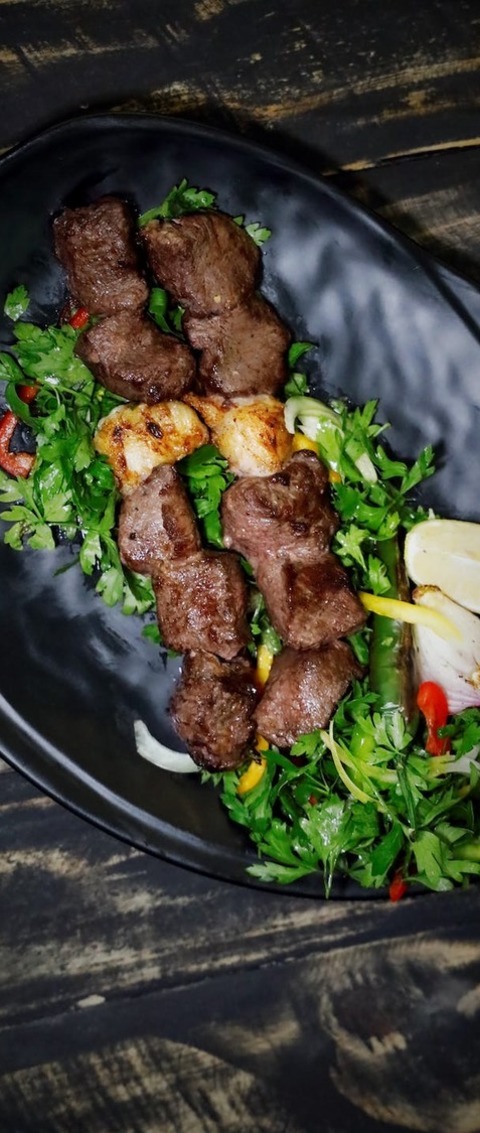
Grilled Beef Kebabs are a tasty and simple way to enjoy a summer meal with family and friends. The marinade gives the beef a savory and tangy flavor, while the vegetables add a fresh and colorful element to the dish. Made with Garlic Powder, Beef Sirloin, Red Wine Vinegar, Dijon Mustard, Green Bell Pepper, Salt And Pepper, Dried Oregano, Red Bell Pepper, Olive Oil, Yellow Onion.
2 notes
·
View notes